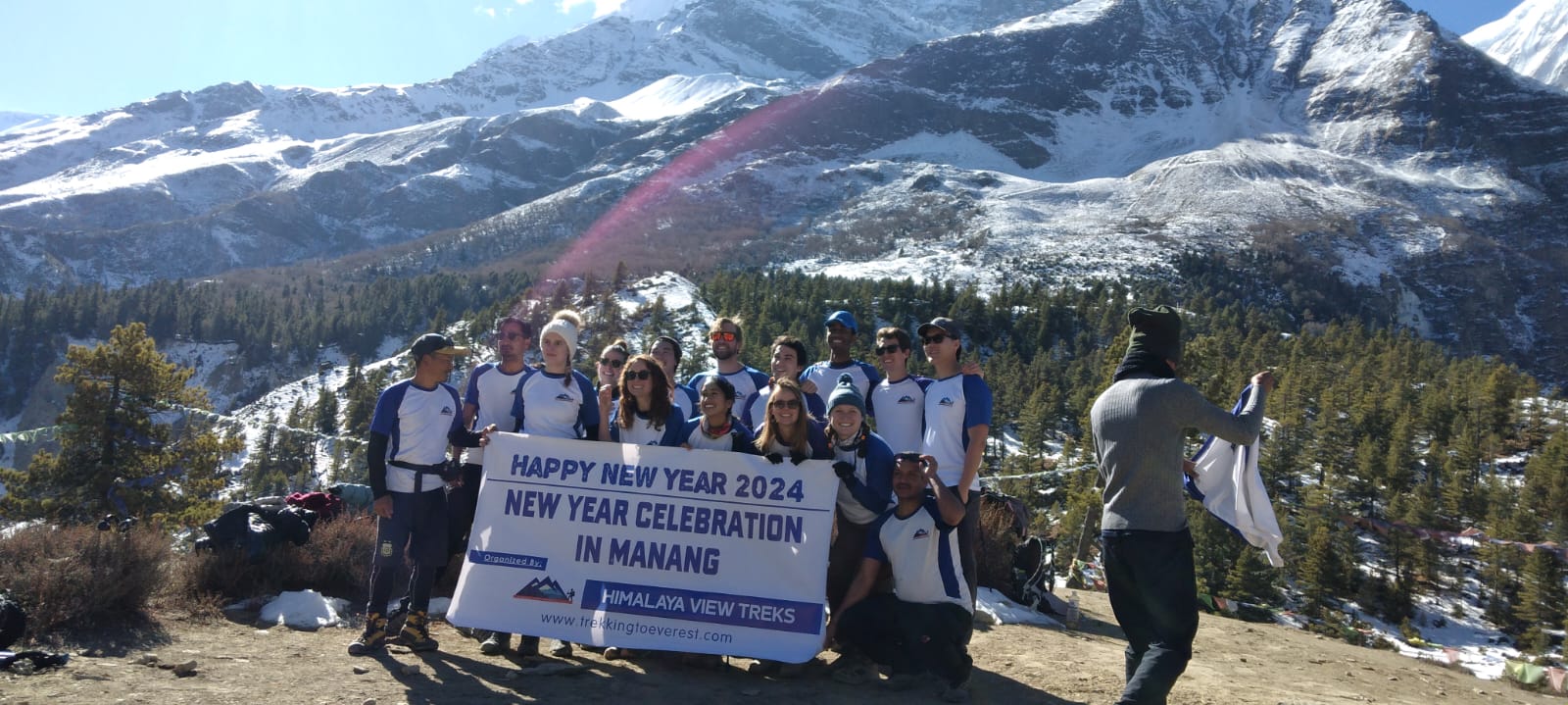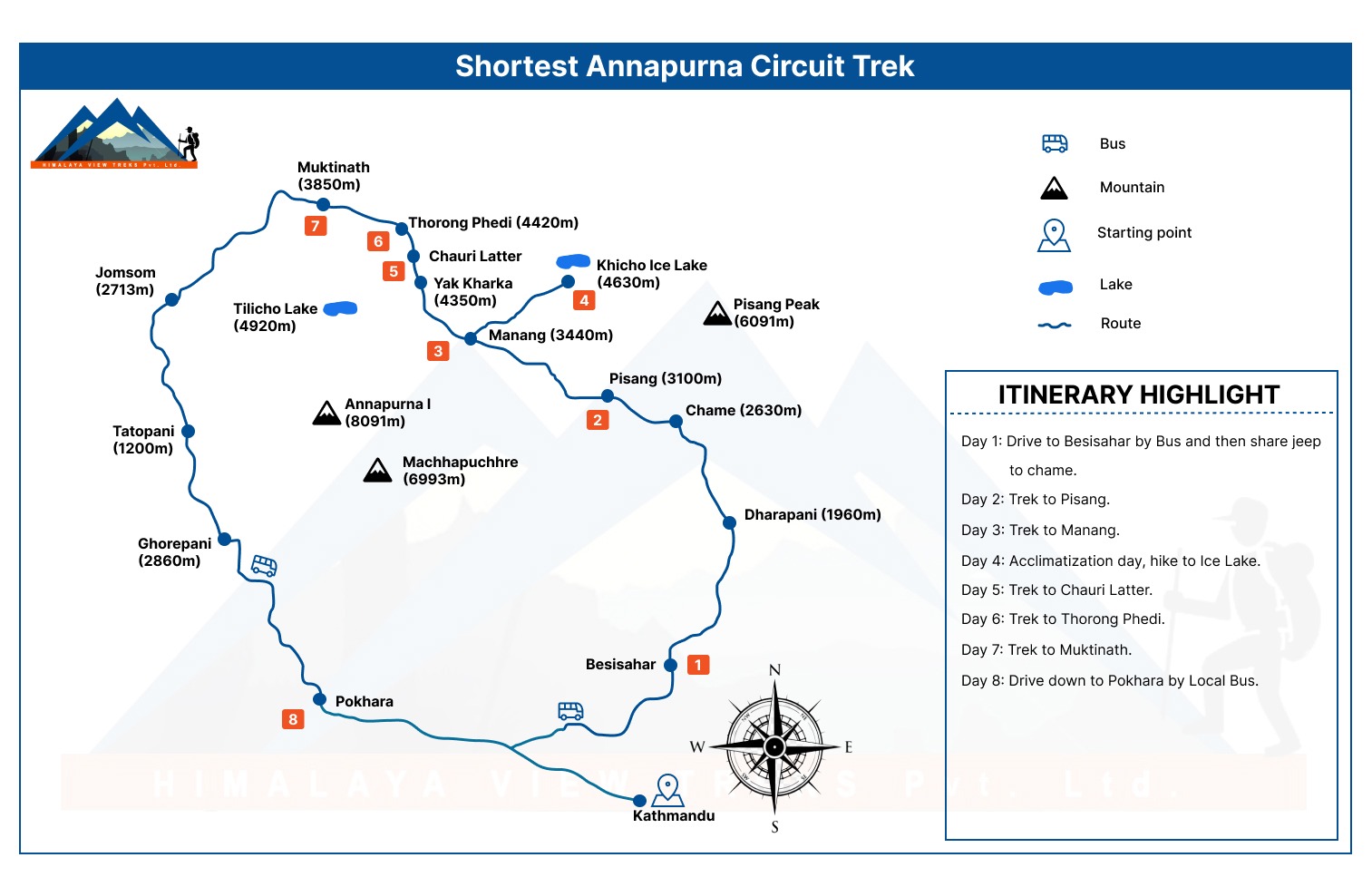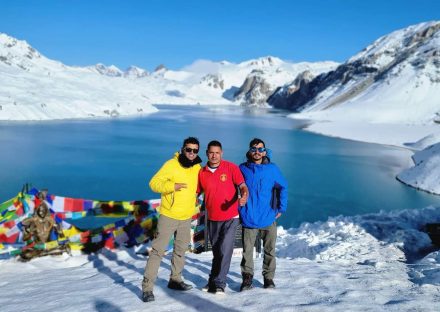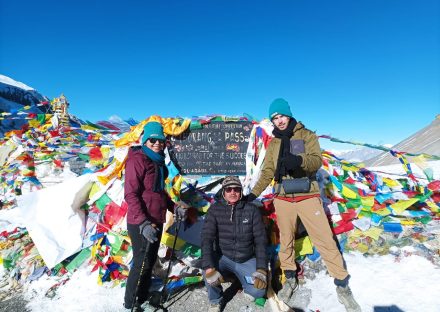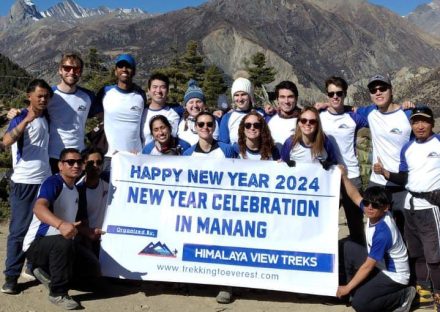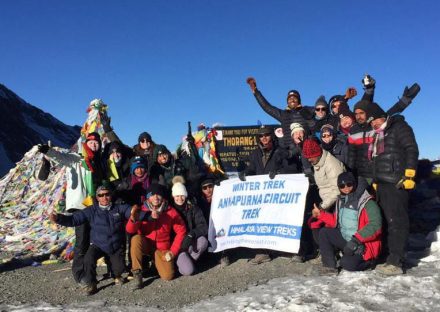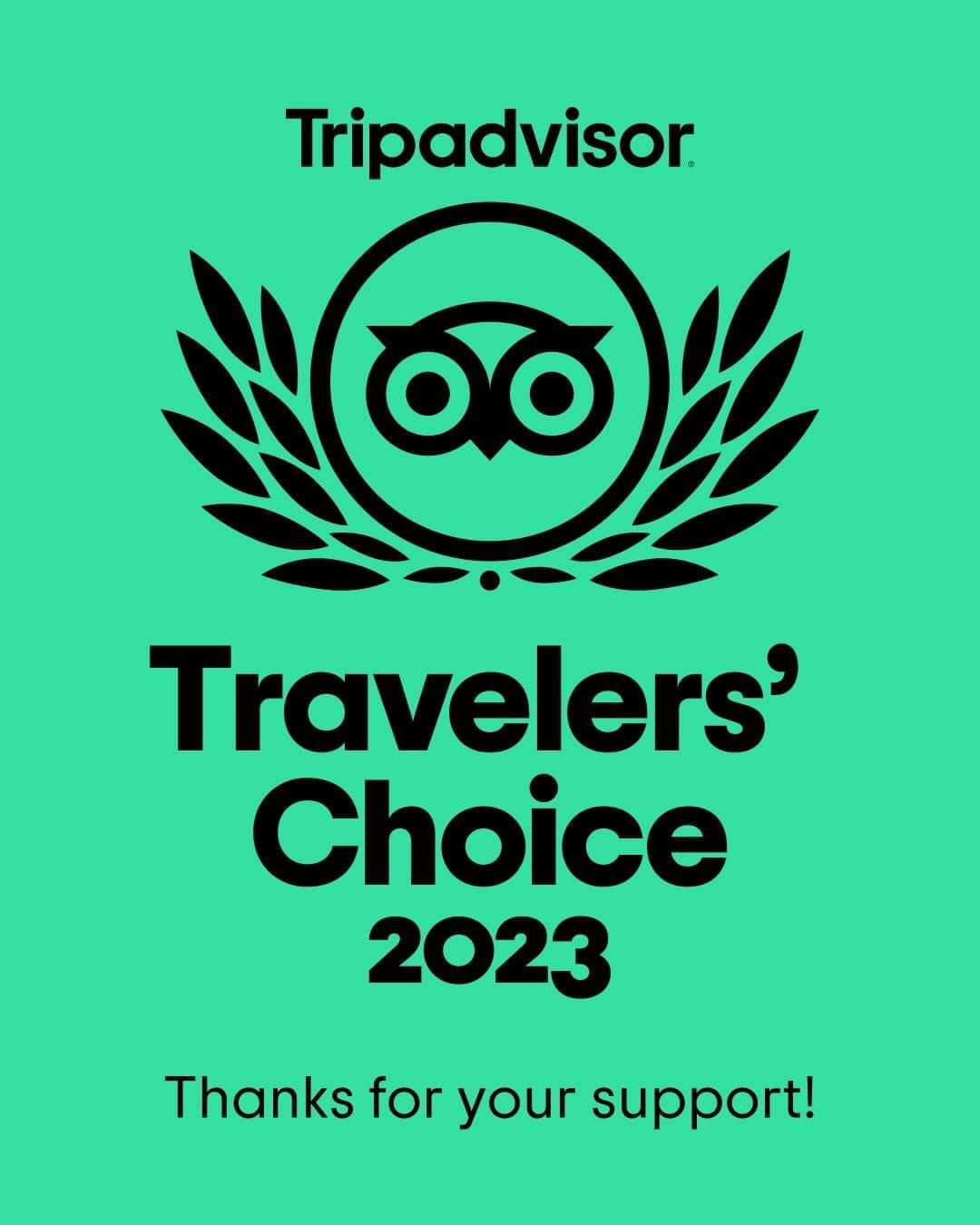- Details
- Short Itinerary
Detailed itinerary
Itinerary- Tour Includes/Excludes
- Useful Info
- Map
- Photos
- FAQ
Trip overview
Shortest Annapurna Circuit Trek – 8 Days
The longest Annapurna Circuit Trek is getting shorter after the road reaches Chame. Therefore it is possible to complete the shortest Annapurna Circuit Trek in 8 days.
We always aspire to offer updated and best holiday itineraries to our clients. Therefore, after the start of the road to Chame from Lamjung Besi Sahar, the Short Way Annapurna Circuit Trekking in Nepal is possible within 8 days. Himalaya View Treks is happy to become your trek companion. We will take you to the mystical Himalayas of Nepal around Thorong La Pass and within the diverse alluring Annapurna region of Nepal.
Usually, AC Trek is the longest trekking trail. We sent our travel planners the latest report about the scenario and trail conditions. Therefore, HVT successfully knitted the Classic Annapurna Loop shorter Trekking Package in Nepal within 8 days. Trekkers will have to take a bus to Besi Sahar and the local sharing jeep to Chame, Shortest Annapurna Circuit trek breakdown cost as per group size. Book Now your next Adventure 8 days Short Trek 2025 / 2026. Annapurna Circuit The 8-day Round Annapurna Thorong La pass Trip Itinerary includes the general route and minimum required days.
Shortest Annapurna Circuit Trek – Relish wilderness
Furthermore, the walking activity starts from Chame and traverses through various quintessential hamlets. Also, Trekkers will encounter countless mountain vistas like Tilicho, Manaslu, Annapurna III, Gangapurna, Chulu East, Chulu West, Pisang, etc. Trekkers will reach the Manang Village passing by Pisang Village. Acclimatization rest is in Manang. Trekkers will then head to Thorong Phedi via Yak Kharka.
The enthralling day of trekking is during the crossing of Thorong Pass. It is probably the most memorable section of the trip. Trekkers can get an outstanding view of mountains and landscapes. You will encounter the beautiful Lower Mustang area on the other side of the pass. The highlight of the section is the Muktinath Temple. It is the symbol of religious harmony. Although, trekkers will be able to understand the great combination of culture and nature in Nepal. Moreover, the Shortest Annapurna Circuit trek Itinerary leads you from Chame after a Jeep ride From Kathmandu. The trek required only 8 days From Kathmandu. If you have more holidays and want to do bit longer trek then you can add Tilicho lake with Annapurna Circuit 11 Days in same trip, or 3 day 2 Night Chitwan Jungle safari after the Trek.
Short Itinerary
Shortest Annapurna Circuit Trek - 8 days Itinerary
Day 01: Drive to Besisahar by bus and then share jeep to Chame (2650m.) 9 hours drive) overnight at tea house.
Day 02: Trekking to upper Pisang (3300m.) 6 hours walking) overnight at tea house.
Day 03: Trekking to Manang (3519m.) 5 hours walking) overnight at tea house.
Day 04: Acclimatization day, hike to ( Ice Lake 4620m. ) or Gangapurna Base camp, Overnight at same tea house.
Day 05: Trekking to Chauri Lader (3720m.) 3/4 hours walking) via Yak Kharka overnight at tea house.
Day 06: Trek to Thorong Phedi (4450m. (Thorong High Camp 4880m.) 3/4 hours walking), overnight at tea house.
Day 07: Trek early in the morning from Thorong Phedi to Muktinath (3710m.) via Thorong La Pass (5416 m 8 hours walking) to Muktinath (3710m.) overnight at tea house.
Day 08: Drive down to Pokhara by Local Bus (822m.) 10 hours drive) overnight at your hotel in Pokhara.
Detailed Itinerary
Day 01: Drive to Chame
Drive to Besisahar From Kathmandu by Local bus and then sharing Jeep to Chame (2650m.) about 9 hours drive) overnight at comfortable tea house.
Day 02: Trek to Pisang
Trek to Upper Pisang, via Dukur Pokhari through Marsyangdi River (3300m.) 6 hours walking) overnight at comfortable Lodge.
Day 03: Trek to Manang
Trek to Manang, Via Upper Pisang and Ngawur Village, from Upper way you will able to see unforgettable Mountain Views. (Manang 3519m.) 5 hours walking) overnight at tea house.
Day 04: Acclimatization Day
Acclimatization day In Manang, Today you can hike either Gangapurna view point or hike to Ice Lake. you can decide as you feel. Overnight at same tea house in Manang.
Day 05: Trek to Chauri latter
Trek to Chauri latter, Today is easy and short trek. Once you get hotel check in Room and have lunch and the hike to normally 300m and spent sometime there and back to hotel, this hike will make acclimatize you body and it help for nigh sleep as well good for next day. (Chauri Lader 3720m.) 3/4 hours walking) overnight at tea house.
Day 06: Trek to Thorong Phedi
Trek to Thorong Phedi, today also easy and short day, same as previous day, you can hike to Thorong High camp after the lunch and back to thorong Phedi and then prepare for Thorong La Pass (Thorong Phedi 4450m.) 3 hours walking). overnight at tea house.
Day 07: Thorong Phedi to Muktinath Via Thorong La
Early in the morning 3:00 Am have some hot drinks and then trek to Muktinath via biggest Pass of the world Thorong La Pass (5416 m 8 hours walking) to Muktinath (3710m.) overnight at tea house.
Day 08: Drive to Pokhara from Muktinath
Drive from Muktinath to Pokhara by Local Bus (Pokhara 822m.) 9/11 hours drive) once you reach Pokhara you can good bye your guide and porters. over night at your own hotel in Pokhara.
Included
- Kathmandu to Chame and Muktinath to Pokhara by Local bus and sharing Jeep
- All meals (Breakfast, lunch, and dinner) during your Annapurna Circuit Trek
- ACAP permit and TIM’s card permit
- Government licensed holder, fluent English Speaking, Familiar HVT guide
- One assistant guide if Group sizes is more than 10 trekkers)
- Strong local Porters for Carry trekker’s luggage One porter every 2 trekkers
- Guide and porter wages including their meals, accommodation, and Salary
- Staff insurance including medication coverage
- Equipment for the Company staff
- Water purification drop or tablets for safe drinking water
- Seasonal fresh fruits every day during Annapurna Circuit trek
- Oximeter to measure Pulse and oxygen level
- Company T-shirt as a Souvenirs, and duffle bag if needed
- Local government, taxes, including official Service Charge
- Trip completion Certificate
Not Included
- Hotel accommodation and meals In Kathmandu and pokhara
- Personal expense (shopping, snacks, boil bottle water, hot (tea, coffee) and cold drinks, hot shower, alcohol, Wi-Fi, telephone call, battery charge fee during the Annapurna Circuit Trek.
- Personal clothing and trekking gear
- Personal travel insurance including evacuation coverage (compulsory) up to 6000m)
- Additional costs if outside the itinerary
- All the costs and expenses which are not mentioned in includes list.
- Tips for guide and porters in end of the treks
Useful Info
Annapurna Circuit Short Trek - Key Highlights:
- World's most popular High Pass (Thorong La Pass (5416 m))
- Manang Valley
- Lower Mustang Region
- Muktinath Temple
- Over 2 Dozen Mountain Vistas
- Oldest Monastery & Thakali/Gurung/Tibetan culture
- Green Lush Forests, Rivers, Waterfalls & Lakes
Annapurna Circuit Entrance Permit
Annapurna Area Conservation Project ACAP Permit RS 3000 per person if you are from SAARC country then RS 1000
TIMS – US$ 20 per person if you are from a SAARC country then US$ 10
Is Annapurna Circuit your ideal trek?
Trekking in the Annapurna region is all about attitude. By its very nature adventure travel involves that you be prepared for the unexpected. In far-flung and developing countries do not expect the standards you are used to at home. Remote areas are sometimes unpredictable and itineraries may be altered. To enjoy your trip and get the most out of your adventure you must be flexible, positive, and eager to take on all the challenges that arise from your Annapurna Circuit odyssey. If you’re a greenhorn in the wilderness world then this trek would be ideal for you.
To truly enjoy this trip, you should be pretty habituated to walking 4-6 hours each day for several days on the go while some days will be relatively longer. We encourage you to walk at a pace that suits you without any rush whatsoever. This is a key aspect of enjoying such trips in the planet’s most popular region. You ought to be physically fit and an active walker to get the best of this classic mountainous journey.
General information important to this trip:
Difficulty levels
TREKKING AT HIGH ALTITUDES (over 3500m)
This trip includes strenuous trekking at altitudes of over 3500m. For us, altitude is a very serious issue, a result that has kept our records clean making us one of the best adventure operators in Nepal for over 30 years of operating treks in the region. Our trekking guests must be in excellent health and have high fitness levels to attempt this trip, as well as be committed to training to ensure you are suitably physically prepared for the tough challenges that go above 4500m.
Altitude sickness is a risk for anyone, including on the Annapurna, Langtang, and Everest Base Camp treks. Please make sure you familiarise yourself with signs and symptoms before you depart and monitor your health during your trek, without letting it worry you.
We advise all our guests to undergo a thorough medical with their physician before they embark on this trip.
Participating in a group trip
When you travel with a group you will find much camaraderie and all the fun and also there’s bound to be some of the frustrations of traveling in a group. Your group mates will probably come from all corners of the world and you will come across a range of age groups too. We ask you to be understanding of the various needs and preferences of your group - patience with your fellow travelers is sometimes required for the benefit of everyone's travel experience. Remember too that you have responsibilities to the group. If you are requested to be at a place at a certain time, ensure you’re on time without keeping the rest of the group waiting. Experience has taught us often that the very best trips we operate are those where the chemistry within the group works well - this requires a ‘give a little take a little’ attitude effort on your part. For privacy reasons, we are unable to provide you with contact details and any personal information about your fellow travelers booked on your trip before departure.
TRAVELERS who prefer going SOLO:
Our group trips are generally planned for shared accommodation and don't involve single supplements. Single travelers share with people of the same gender in accommodations ranging from twin to multi-share. Some of our itineraries have accommodation booked on a mixed-gender share basis [for couples or trekkers known to each other before the trip]. On a selection of our trips, you have the option to pay a single supplement to ensure that you have your accommodation (where available). Please note that this only applies to accommodation during the trek - pre-trip and post-trip accommodation will be booked on a single-room basis at your hotel in Kathmandu. We also have arrangements for guests who wish to trek completely solo out of the group.
Travel Insurance
when booking with Himalaya View Treks, it’s a condition upon joining any of our trips that all clients must be insured for comprehensive expenses that might incur due to medical issues or accidents (this includes air ambulance, helicopter rescue, and treatment costs). Please note that we don't arrange or sell insurance because such a system is not allowed in our country.
Our Cost versus the Experience
At Himalaya View Treks, we always go the mile to ensure our trekking guests get the best experiences of the trip with maximum comfort and safety on a ratio that goes beyond the cost that we charge for the trip. We provide a ‘no frills’ price with breakdowns to make sure our clients are getting the best for a cost that goes beyond all expectations
Tipping [an expectation on such risky arduous trips]
Tipping is very much part of the culture in Nepal and although entirely at your discretion, it is usually expected. Often people would like to tip in recognition of good service but are unsure how much would be appropriate in a foreign country - for this reason, we have listed guideline amounts below (these are intended as a guideline only and you may see fit to give more or less depending on the service that you have received).
For the tipping of your trek staff and your tour leader, we suggest passing an envelope for each staff member around the group so that everyone can put in what they feel comfortable with anonymously.
Normally 25% to 35% your guide and porters expect Tips that you paid for your trip in the company.
Acute Mountain Sickness [AMS]
When we ascend above 2500 meters our bodies have to acclimatize to the decreasing amount of oxygen available. So, to allow our bodies to adjust we have designed our treks in ways that help you ascend slowly, allowing acclimatization to occur when you go above the tree lines where the air is thinner. However, during the acclimatization process, you may experience some of the following symptoms.
- Headache
- Tiredness
- Disturbed sleep patterns
- Loss of appetite/nausea
- Shortness of breath
- Cough
- Palpitation
- Swelling of the hands and face
But if you feel such symptoms don’t let it worry because it’s normal. Individuals acclimatize at different rates. Some may experience symptoms, some may not. Your best strategy is to take your time and drink plenty of water. These symptoms may not indicate the onset of A.M.S.; if you experience them, it does not necessarily mean that you should not continue. All our group leaders have extensive first-aid training and we urge you to communicate with the group leader at all times should you believe you have any symptoms so that we can effectively monitor your symptoms as you go higher. The only cure for Acute Mountain Sickness is to descend. Please note, that your group leader has ultimate responsibility and may ask you to descend if symptoms persist. As a last resort, if matters grow from bad to worse, we always have a helicopter on standby for immediate evacuation.
A Typical Day on the Annapurna Circuit Journey
A typical day on the trail begins with a wake-up call at around 6 AM by your guide. Freshen up and get ready. Pack your belongings and head to the dining area for breakfast by 7 AM. Check your luggage for the final time and fill your water bottle before you hit the trail by 8 AM, along with your guide.
To avoid walking in the heat and enjoy clear mountain views, you make an early start. En route, there will be short breaks to enjoy the views and take photographs. You haul up for lunch at a local teahouse around noon or mid-day. After a quick rest of about an hour or 40 minutes, you get back on the trail and continue till you reach your overnight stop.
Upon reaching the stop for the night, you head to your teahouse, check-in, and have some rest. Tea with some light refreshments (cookies or biscuits) will be served at 5 p.m. As the rooms are not insulated, you can warm yourself with the heater or stove in the communal area.
Exchange stories or play cards with other trekkers and Sherpas till dinner is served (around 7 PM). After dinner, your guide will brief you about the next day’s trek – the route you will take, the difficulties, where you will stop for lunch, etc. Afterward, retire for the night and have a well-deserved rest.
Equipment for Nepal Trekking
This section is intended to provide information on clothing and equipment requirements for Nepal Trek. It is not intended to be a final and authoritative checklist. For those who would like a more detailed discussion of these issues, we ask you to contact us at singbir@yahoo.com or via WhatsApp at +9779841146306
The following is a list of clothing and accessories that we recommend that you take with you. This is not intended to be a comprehensive clothing and equipment list, rather it is intended to act as a reminder of those items that we feel are essential for your comfort and convenience. However, we recommend that you may have your own personal preferences for clothing which may be equally as suitable.
Footwear: Equipment for Nepal Trek
- Walking boots with suitable ankle support that have been worn prior to the trek, and which are waterproof
- Trainer or casual shoes, for trekking and/or traveling
- Warm socks for colder areas
- Gaiters, in case of rain or snow
Legwear
- Loose, casual trousers for trekking
- Thermal leggings for colder areas
- Long skirts for women as an alternative to trousers
- Waterproof trousers
Body
- Selection of T-shirts, and long-sleeved shirts, preferably not cotton
- Thermal shirt for colder areas
- Warm shirt, possibly fleece, for colder areas
- Fleece jacket or warm wool jumper
- Windproof, waterproof outer shell garment for higher altitudes
- Down jacket (optional for cold nights & mornings; can be hired in Kathmandu cheaply)
Head / Hands
- Wool or fleece hat, or balaclava
- Hat or cap for sun protection while trekking
- Sunglasses or goggles
- Warm gloves
Other Items
- Strong rucksack or large hold all to be carried by porters
- Day sack to be carried personally
- Plastic bags or stuff sacks to store/separate trekking gear inside your main bag
- One-liter water bottle
- Personal first aid kit to include essential items
- Sleeping bag, 4 season
- Torch, ideally head torch
- Camera and film! – For those not-to-be-forgotten shots of the Himalayas
- Toilet items and towel
- Large handkerchief/bandana for neck
Optional Items
- Binoculars
- Books (see Recommended Reading)
- Altimeter
- Compass
- Playing cards/backgammon/chess set
Best Time of the Year
Trekking is possible at any time of the year depending on where you are going. The most popular seasons are spring (February-May) and autumn (September-December). Winter is very cold above 4000m. And high mountain passes may be snowbound, but it is good for trekking at lower altitudes. During the monsoon season (June-August), you can trek in the rain-shadow areas north of the Himalayan like the Mustang, upper Manang, and Dolpo. These places are out of reach of the rain clouds because of the high mountains and are unaffected by the monsoon.
Are You Already in Nepal?
If you are already in Kathmandu or Pokhara and seeking to Hire a guide/porter or tour/trekking packages, you can directly contact an expert via WhatsApp at +9779841146306. Or visit our office:- Himalaya View Treks Kaldhara Marg, Kathmandu 44600, in front of the Kathmandu Sport Climbing Center 1st-floor building.
Moreover, you can book this trip on your own date for 2025/2026, we have plenty of departure dates available for 2025/2026.
FAQs
-
Is it hard to do Annapurna Circuit Trek in 8 days?
Yes, it is possible. Expert planning in designing the itinerary is needed for the successful trekking. Our travel planners have worked very hard during pandemic to shorten the circuit trek. The company invested in private research trek to knit the short itinerary. The itinerary consists of Manang Acclimatization too. Therefore, it avoids the risk of altitude sickness also. Don't worry and follow the instructions of the trekking guide. You will be able to complete the trek in 8 days.
-
What should i do before trekking? My Physical fitness status?
Annapurna Circuit Trek is relatively easy trekking route except the day of crossing the Thorong La Pass. However, you need to be physically fit. We are challenging to complete the trek in just 8 days. Therefore, one month before the trek, do some gentle walking exercises. Cardio exercises are helpful. For example, do some cycling and long hours of walking/jogging.
-
What are things do i need to do besides preparing the physical fitness level? Eating Habits?
Please avoid eating greasy food one month prior to the trekking. Avoid drinking beer too. If you really need to drink alcohol, limit to one - two pint. Make sure to do extra jogging or cardio exercises.
-
Do i need Travel Insurance for the Trek?
Yes, Insurance is highly needed. In fact, it is mandatory. We are directly traveling to Chame which is 2600 m from Kathmandu 1300 m. Therefore, slight difficulty might appear. But the altitude effects start to appear only after 3000 m. Our travel planners prepared this itinerary in such a way that trekkers can avoid the altitude sickness risk. There is road network up to Manang but we will not travel to Manang on vehicle rather we trek after staying in Chame. However, you need to take the insurance as our trekking reaches as high as 5416 m. It is better as well as mandatory to do take the insurance.
-
What is the difficulty level of the trek?
The trekking is moderate to easy. The only difficulty is while we trek from Phedi to Muktinath crossing the Thorong La pass. We have to cover 1000 m on this day. However, normal route is Yak Kharka to High Camp which make it easier to cross the pass. However, the guide will assess your condition. He/She will decide whether to push for High camp or Phedi. Besides this day, almost every day is easy walking trail.
-
How many hours of walking in a day?
We will have to walk for about 6-7 hours in a day. Thorong La Pass Crossing day requires more hours which is about 7 - 8 hours.

